On the Way to Santa Fe
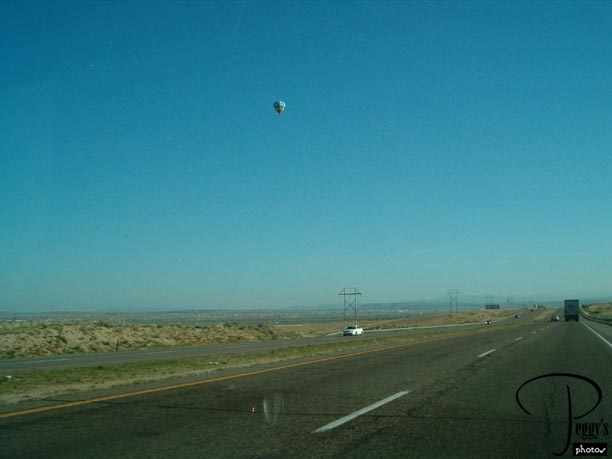
Santa Fe (at 7,000 feet elevation) is a very easy hour’s desert drive north from Albuquerque (at about 5,000 feet elevation––a good part of the drive has a 75 mph speed limit). If you come to New Mexico to visit Santa Fe, your plane will land in Albuquerque. There are probably some shuttles to get you from there to Santa Fe or you need to rent a car. However, the train line from Albuquerque is expected to go all the way to Santa Fe in the near future. Linda took photos on our drive and I drove. Photo: On the way through the desert to Santa Fe. The balloon on the left of the photo is an added blow–up of the balloon in the middle of the photo. I don’t believe that a balloon ride will get you all the way to Santa Fe, but hot air balloons and Albuquerque go together. The Albuquerque International Balloon Fiesta, a huge event with hundreds of balloons flying, will be held this year from October 6–14. (Linda’s photo)

On the Way to Santa Fe
Santa Fe Tram Tour
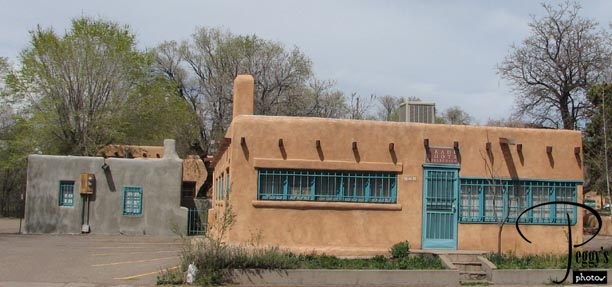
An art gallery that we passed.

Santa Fe Tram Tour
On the Way to Santa Fe
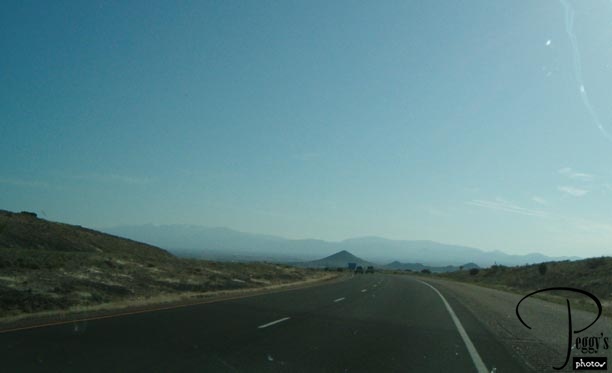
Getting closer to Santa Fe, with the Sangre de Cristo mountains in the background. One odd thing about the drive to Santa Fe is that most of the signs directing you north direct you to Las Vegas––that is, Las Vegas, New Mexico. (Linda’s photo)

On the Way to Santa Fe
Santa Fe
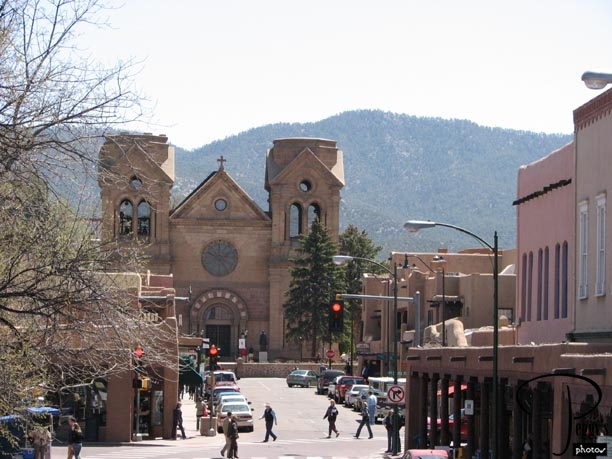
We parked at the parking lot of the beautiful La Fonda hotel right near the Cathedral. The hotel is worth a walk–through. Photo: Our first look at the historical area of Santa Fe and the Cathedral Basilica of St. Francis of Assisi (1869).

Santa Fe
Santa Fe
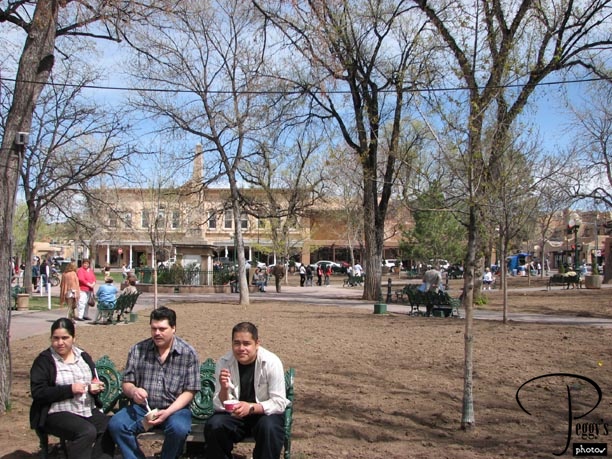
View of the Plaza, a short walk from the Cathedral. Santa Fe was established 400 years ago in 1607. It is the oldest capital city in North America and the second oldest city in the United States (St. Augustine, Florida, is the oldest). Buildings were built around the Plaza.

Santa Fe
Santa Fe
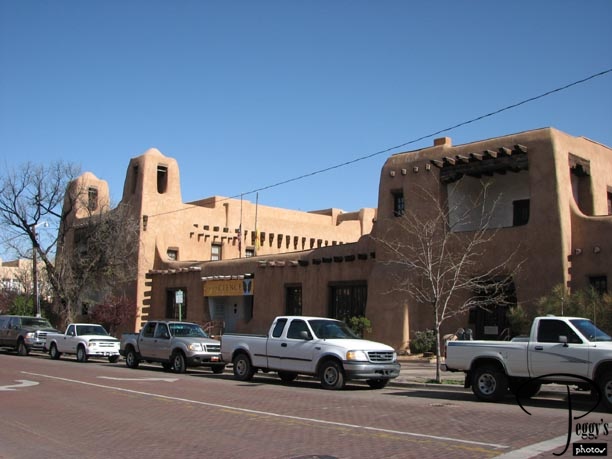
Our first stop was to see the Jack Kerouac exhibit at the Palace of the Governors. The building in this photo looked like it could be a palace but it was listed on our Santa Fe map as the Museum of Fine Arts, built in 1917 in the Spanish pueblo style.

Santa Fe
Santa Fe
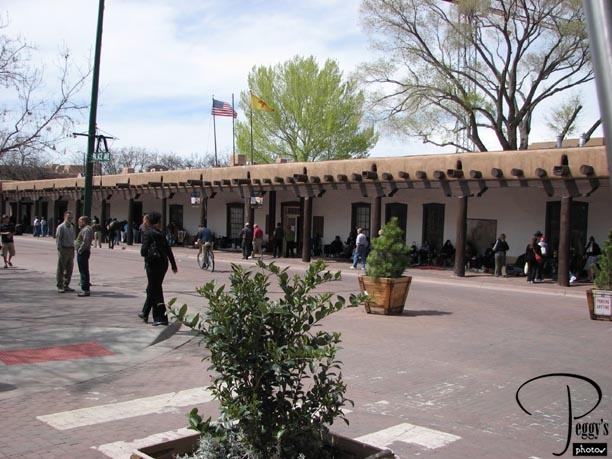
We asked a fellow tourist where the palace was and were directed to this building across from the museum––no, it doesn’t look at all like a palace. In 1608–10, Don Pedro de Peralta chose Santa Fe as the capital of the Spanish “Kingdom of New Mexico” and named the city La Villa Real de Santa Fe de San Francisco de Asis––the Royal City of the Holy Faith of St. Francis of Assisi. Peralta’s palace was the core of the original settlement and it is now one of the oldest public buildings in the United States. It was the seat of government under Spanish, Pueblo Indian, Mexican, and U.S. Territorial rule until 1909. It is now a state history museum, with an excellent collection of pre–Columbian Art from 1500 B.C. to 1500 A.D. Interestingly, the Palace of the Governors was the site of the 1680 Pueblo Revolt.

Santa Fe
Santa Fe
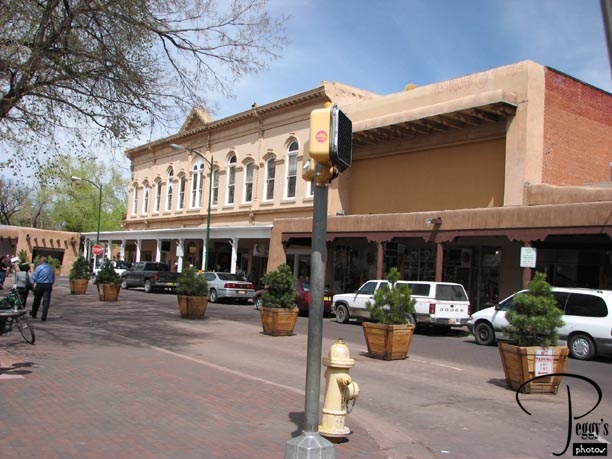
The palace had not yet opened so to fill some time we walked over to the stores located in these old adobe buildings that are on one side of the Plaza.

Santa Fe
Santa Fe
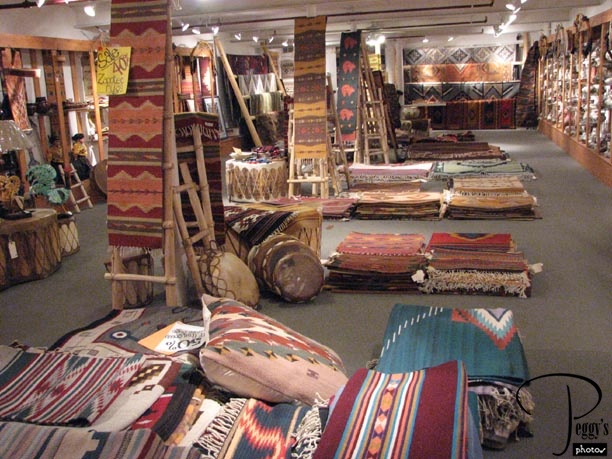
Inside the basement level of a store selling Indian merchandise.

Santa Fe
Santa Fe
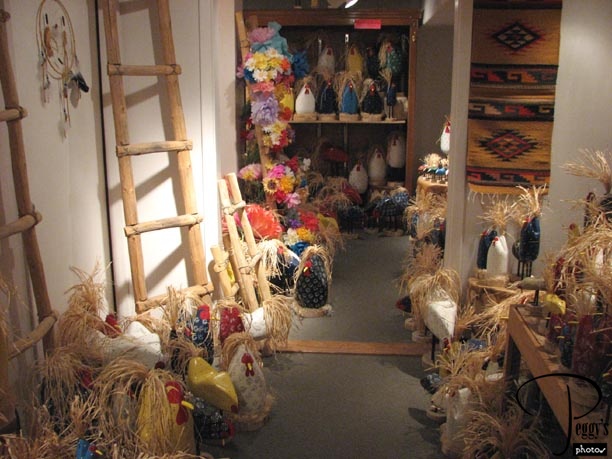
A room full of chickens, all made by a Navajo artist. We saw these chickens being sold in other stores in Santa Fe as well, but this was the best selection.

Santa Fe
Santa Fe
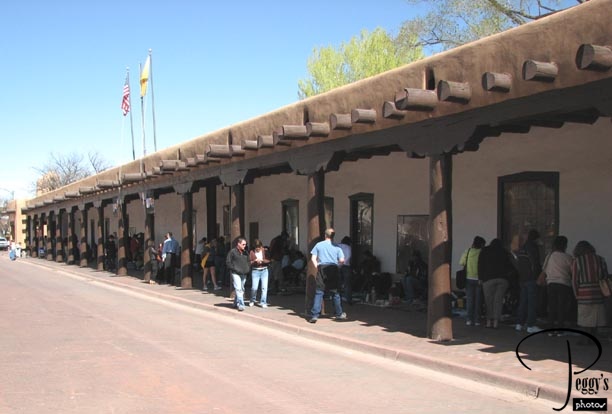
We returned to the Palace of the Governors and went inside to view the Jack Kerouac exhibit of his original “On the Road” manuscript.

Santa Fe
Santa Fe
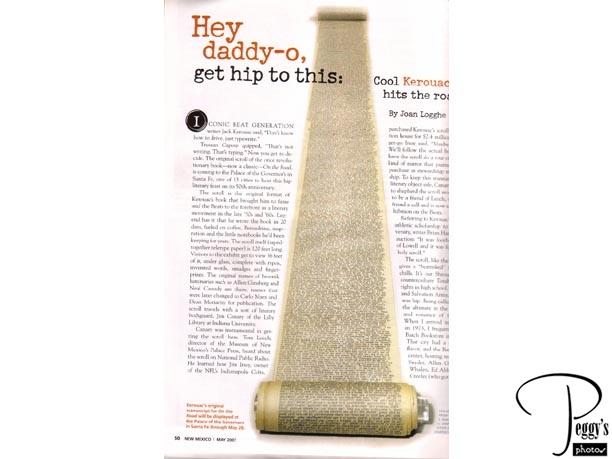
No photos were allowed of the exhibit, so I have scanned a page from a New Mexico magazine showing the manuscript. The orginal “On the Road” manuscript was 120 feet long and 9 inches wide and typed single–spaced on an old Underwood manual typewriter. Mistakes were just typed over. “On the Road” was written in 1951, but not published until 1957. Linda’s and my interest in seeing the manuscript comes from Jack Kerouac having lived for several years in our small hometown of Northport, Long Island, New York during the later 50’s and early 60’s. His mother was already living in Northport when he arrived. Several of the boys who were in high school with me became some of his drinking buddies. Today, Kerouac is considered almost a native son by Northport. Along the walls of the museum were posters of interesting things about Kerouac and some others of the Beat Generation, but the one that I found of most interest was a quote from Kerouac: “Whitman was my first real influence. It was the spur of reading Whitman that I decided to cross the country”––the poet Walt Whitman is a native son of the area of Long Island where Northport is located. Maybe this had something to do with his arrival in Northport.

Santa Fe
Santa Fe
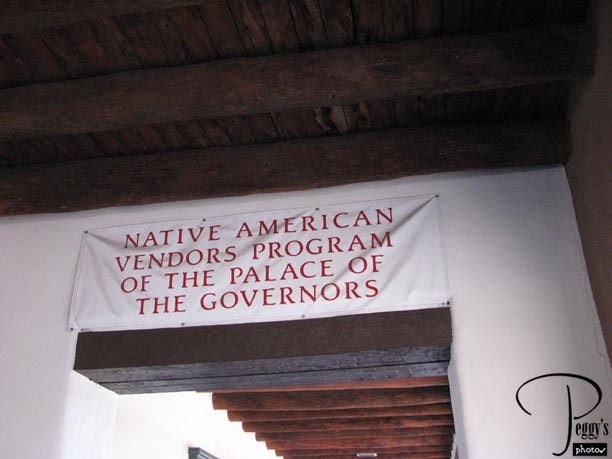
Sign outside the Palace of the Governors. Here “Native American” instead of “Indian” is used. Our later tram tour guide told us that all the vendors here must have selling permits and that all items must be guaranteed to be of both quality and Indian–made, so it is a good place to shop if you want to be sure that what you are buying is authentic.

Santa Fe
Santa Fe
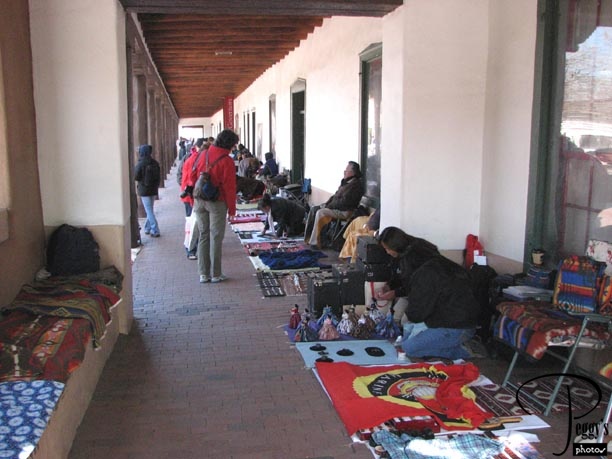
Vendors along the portal of the Palace of the Governors.

Santa Fe
Santa Fe
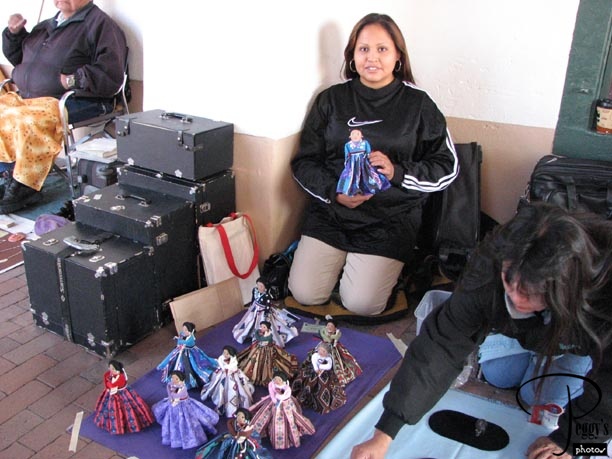
Navajo dolls for sale.

Santa Fe
Santa Fe
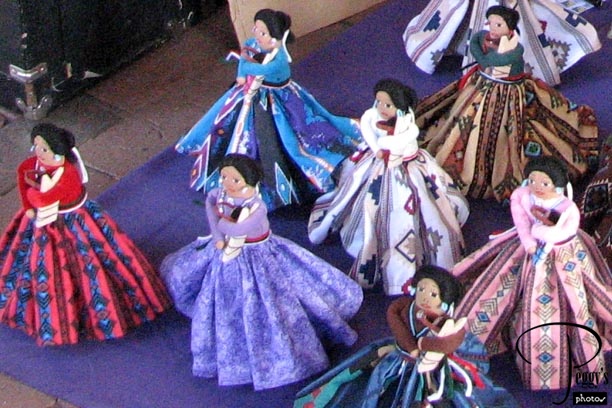
Close–up of the Navajo dolls. I bought two of them––one as a gift and one for myself to remember my trip to New Mexico.

Santa Fe
Santa Fe
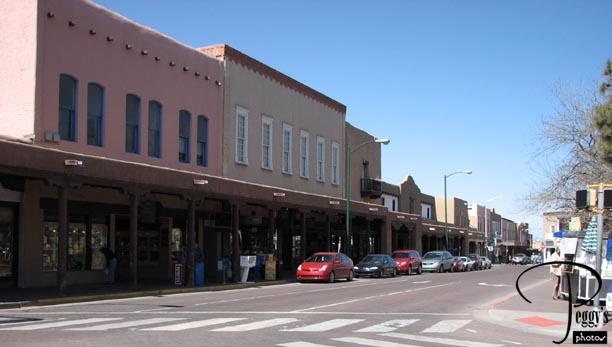
We next walked around the Plaza.

Santa Fe
Santa Fe
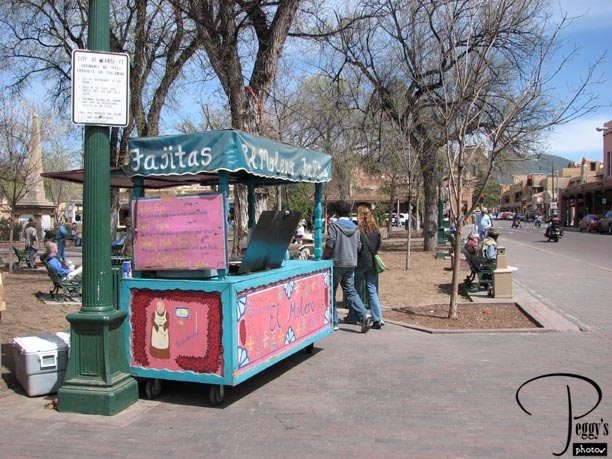
Fajitas for sale in the Plaza.

Santa Fe
Santa Fe
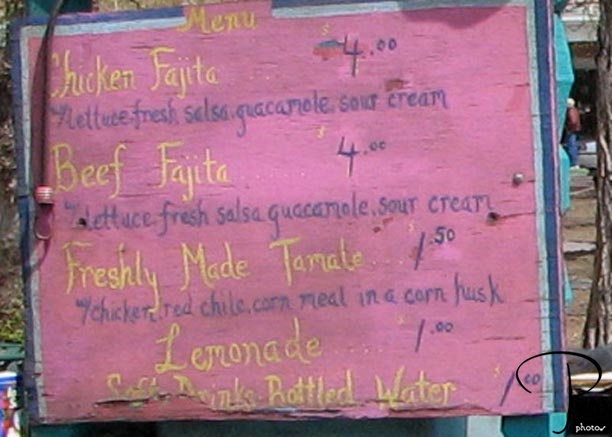
Only $4.00 for a chicken or beef fajita––that is a true bargain. For those not familar with Mexican or Southwest food, a fajita is usually made of strips of beef or chicken or of shrimp, sliced green and red peppers, onions, and chili seasoning and served with tortillas to place the mixture in. Add salsa, guacamole, and sour cream and you have a very delicious dish.

Santa Fe
Santa Fe
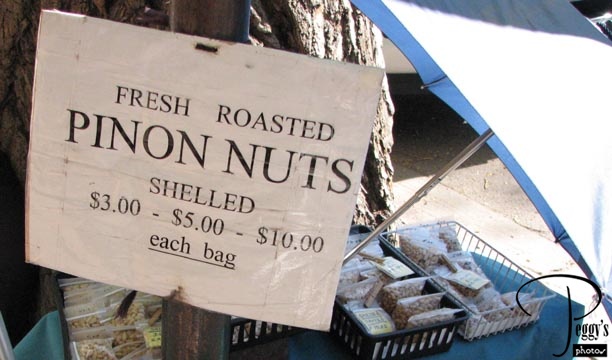
Fresh roasted pinon nuts for sale.

Santa Fe
Santa Fe
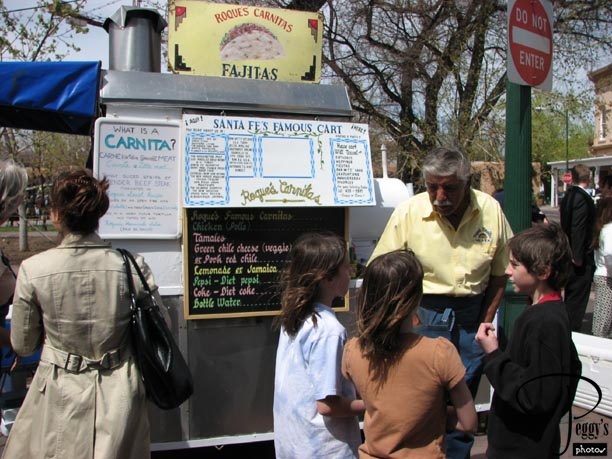
Fajitas and carnitas for sale in the Plaza.

Santa Fe
Santa Fe
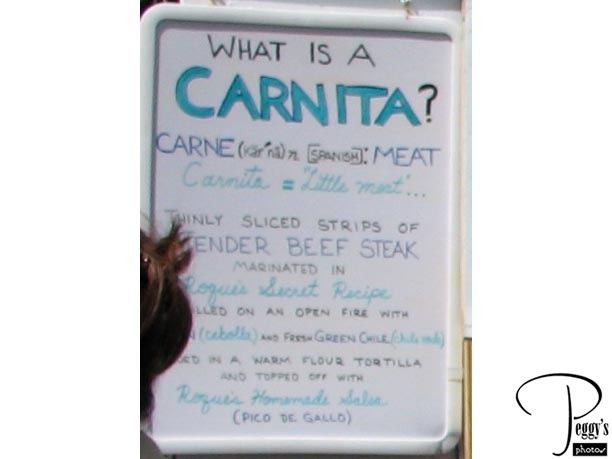
Helpful explanation of what is a carnita.

Santa Fe
Santa Fe
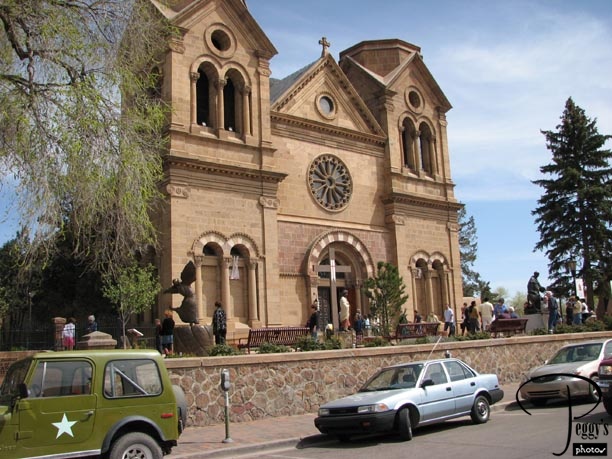
Linda and I walked back to the Cathedral Basilica of St. Francis of Assisi to meet Jack Duvall and his wife Jill Norton, a couple who I had met on my Trafalgar tour of Italy in 2005 and who live in Santa Fe. I was very excited to see them again and our visit with them was definitely one of the major highlights of my trip to New Mexico.

Santa Fe
Santa Fe
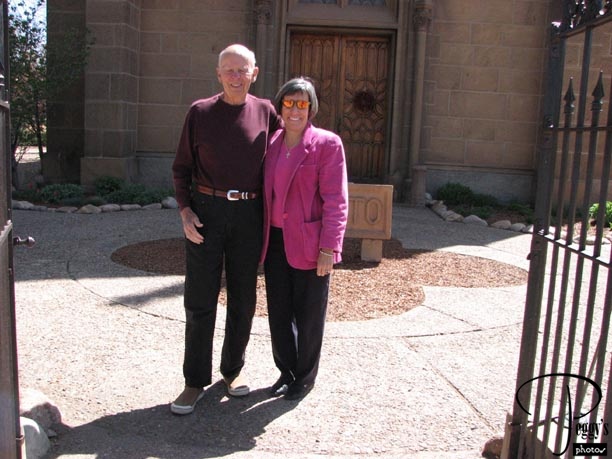
Here’s Jack Duvall and Jill Norton, both looking absolutely great even though Jill was to have an operation the next day (Jack told us that all went well).

Santa Fe
Santa Fe
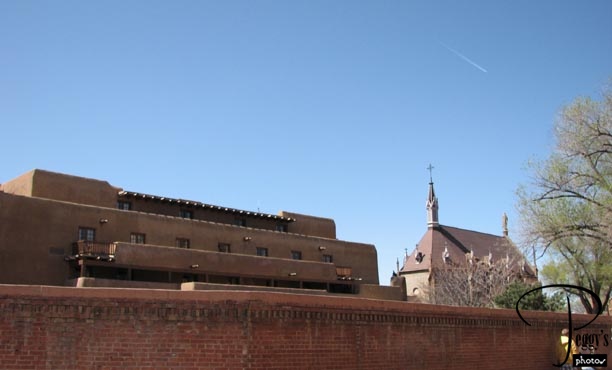
Now Linda and I had tour guides! We had to wait until later to visit the Cathedral as mass was still being conducted in it. We followed our tour guides over to the Loretta Chapel, a short walk away. Photo: Odd juxtaposition of the pueblo architecture of a hotel on the left and the Loretto Chapel of French Gothic architecture on the right.

Santa Fe
Santa Fe
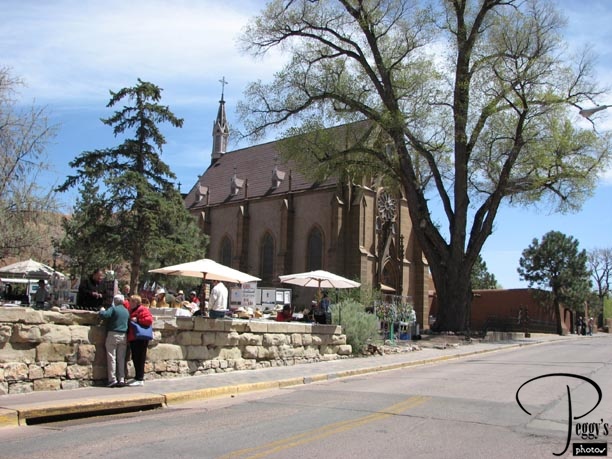
The Loretto Chapel was patterned after Saint–Chapelle in Paris, France. It was constructed in 1873 by the same French architects and Italian masons who constructed the Cathedral (more about this later). It was built as a chapel for the Sisters of Loretto who were brought to Santa Fe by Archbishop Lamy and who established the first English–speaking school in the New Mexican Territory.

Santa Fe
Santa Fe
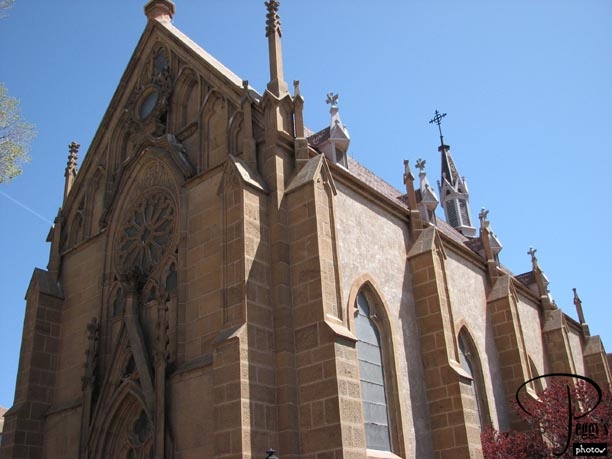
Another view of the Loretto Chapel.

Santa Fe
Santa Fe
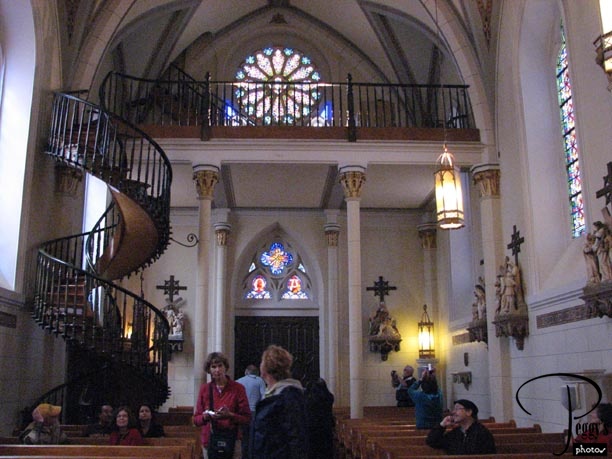
Inside the Loretto Chapel is the “Miraculous Staircase”––on the left of the photo. The staircase connects to the Chapel’s choir loft, with two 360–degree turns with no visible means of support. When the chapel was first built, a ladder was used to reach the choir loft, but the nuns were not comfortable using it. However, they had no money to build a staircase so they prayed to St. Joseph, the patron saint of carpenters, for a solution. A man astride a donkey soon came (some believe to be St. Joseph), carrying with him only a saw and a hammer. He went to work building this staircase, soaking slats of wood in tubs of water to curve them and then held them together with wooden pegs. Even to this day, no one has been able to explain how the staircase was built or stands without any visible means of support. It is considered an engineering feat of wonder. Additionally, in 1996, Forrest N. Easly, a forester/wood technologist, analyzed a wood specimen from the Loretto Staircase and concluded that the specimen was of a previously unknown wood––a wood not found anywhere else on earth. He suggested its common name to be Loretto Spruce. Before collecting his wages, the carpenter disappeared. The staircase railing was added later.

Santa Fe
Santa Fe
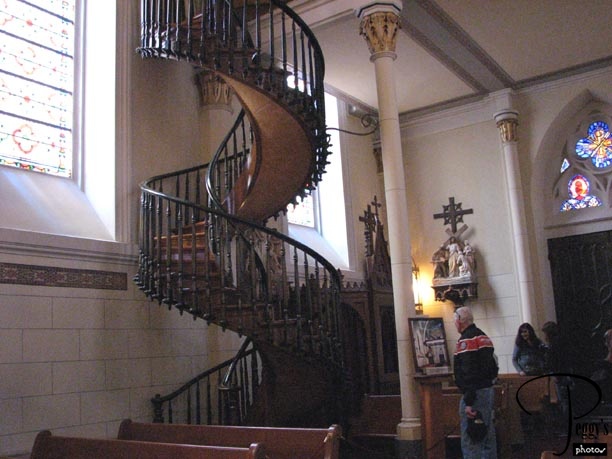
Another view of the “Miraculous Staircase.”

Santa Fe
Santa Fe
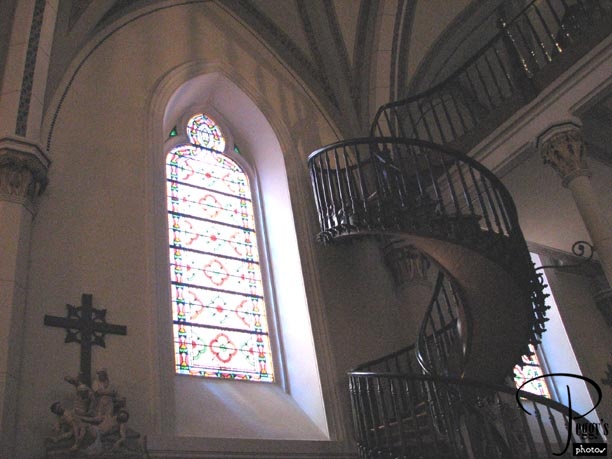
And another.

Santa Fe
Santa Fe
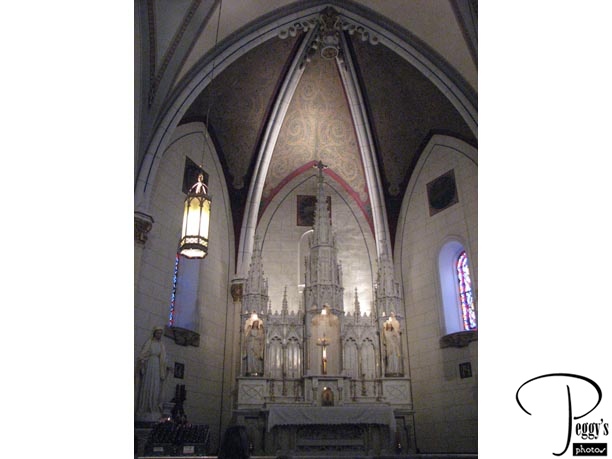
View of the altar.

Santa Fe
Santa Fe
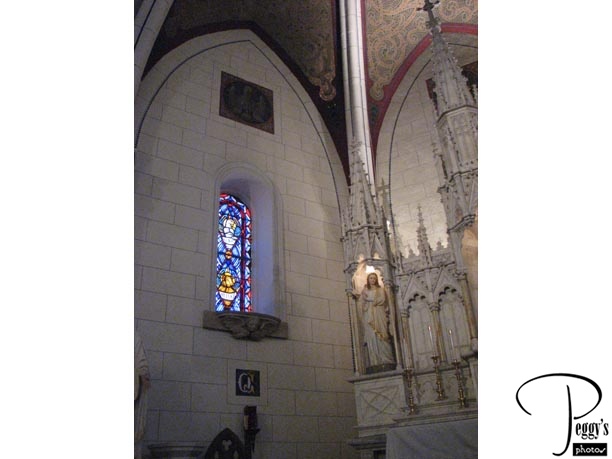
A side view.

Santa Fe
Santa Fe
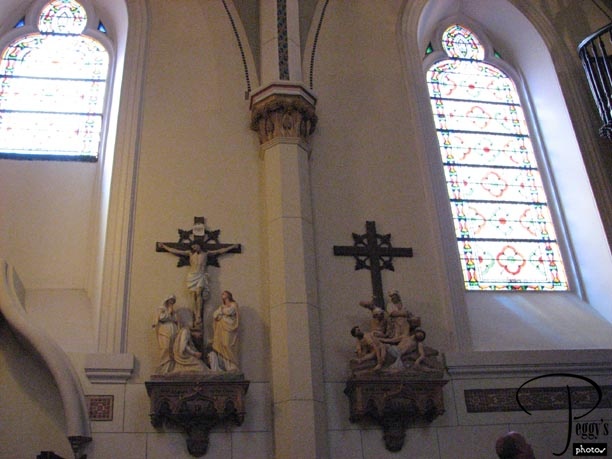
Stations of the Cross. The Loretto Chapel has been deconsecrated.

Santa Fe
Santa Fe
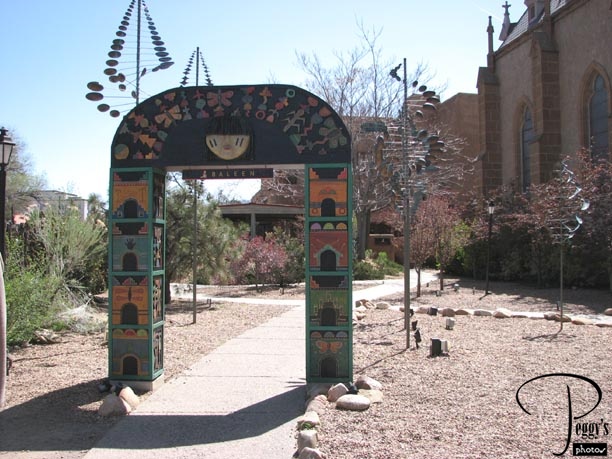
Decorative arch on the grounds of the Loretto Chapel.

Santa Fe
Santa Fe

Close–up of some of the arch’s panels.

Santa Fe
Santa Fe
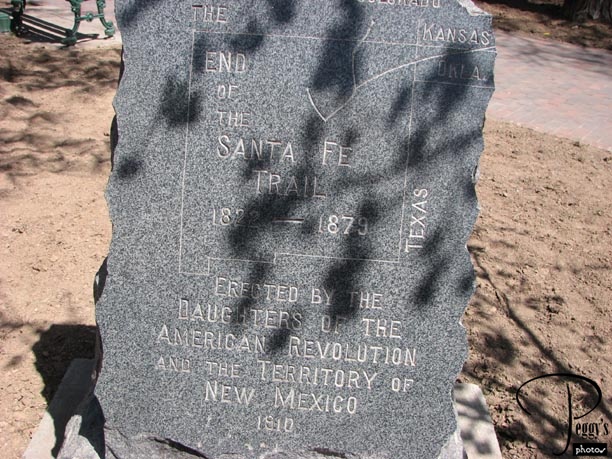
From the Loretto Chapel, we followed our tour guides back to the Plaza, where they pointed out this plaque denoting this to be the end of the Santa Fe Trail, the 780–mile route used in the years 1822–1879 from Independence, Missouri, to Santa Fe. Pioneers made the 40– to 60–day trip via covered wagon. This plaque was erected in 1910 by the Daughters of the American Revolution and the Territory of New Mexico (New Mexico became a state in 1912).

Santa Fe
Santa Fe
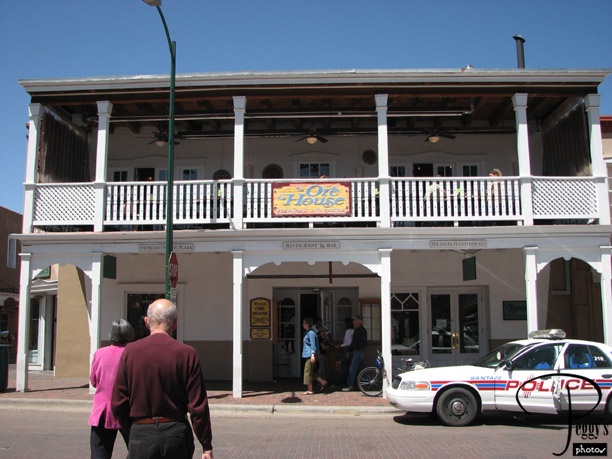
We are now following Jill and Jack to the Ore House restaurant where we had a delicious lunch. We sat on the balcony that overlooked the Plaza.

Santa Fe
Santa Fe
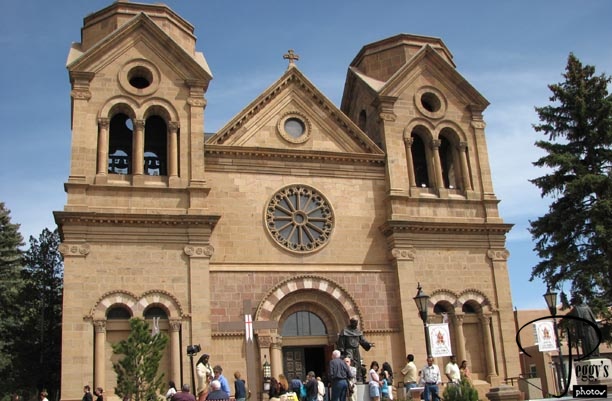
Mass was over and we could now visit the Cathedral Basilica of St. Francis of Assisi, the first church in New Mexico to attain basilica status. The parish was founded in 1610 and the present building dates back to 1869, having been built in the French Romesque style by French architects and Italian masons under the direction of Archbishop Jean–Baptiste Lamy. This is Jill’s parish and she is quite active in its affairs. She and Jack gave us a first–rate tour of the Cathedral.

Santa Fe
Santa Fe
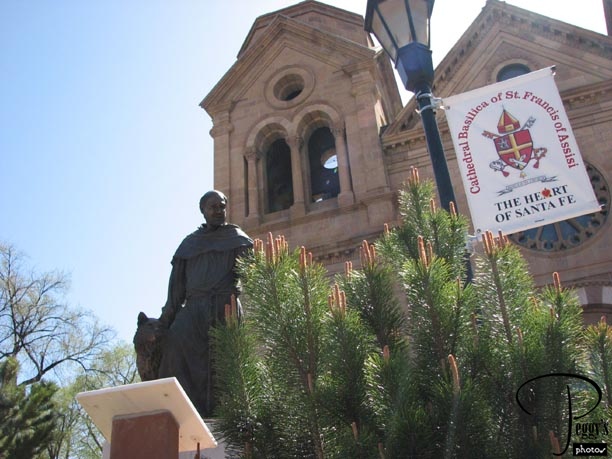
Statue of Archbishop Lamy in front of the Cathedral. Before you come to Santa Fe or even to New Mexico, you’ll want to read Willa Cather’s “Death Comes for the Archbishop,” which is based on Archbishop Lamy’s life in New Mexico. I was sorry that I didn’t read it until I returned home, but then I could picture him in places that I had seen. Lamy, a Frenchman, became a priest in 1838. In 1839, he volunteered to became a missionary in the American West and spent 11 years in Ohio and Kentucky. In 1849, the American Catholic Church’s first plenary council asked Pope Pius IX to separate the New Mexico Territory from the Mexican diocese of Durango. Lamy was appointed the apostolic vicar for the region, but his new authority was rejected by the priests in Santa Fe when he arrived. He then had to make the long journey to Durango, Mexico, to get a letter from the Bishop of Durango verifying Lamy’s authority. In 1853, Santa Fe was elevated to a diocese and Lamy became its first bishop and later became its archbishop. Lamy made a later journey back to Rome and on the way back to Santa Fe, in Kentucky, some of the Sisters of Loretto joined him. Lamy is buried beneath the Cathedral’s main altar.

Santa Fe
Santa Fe
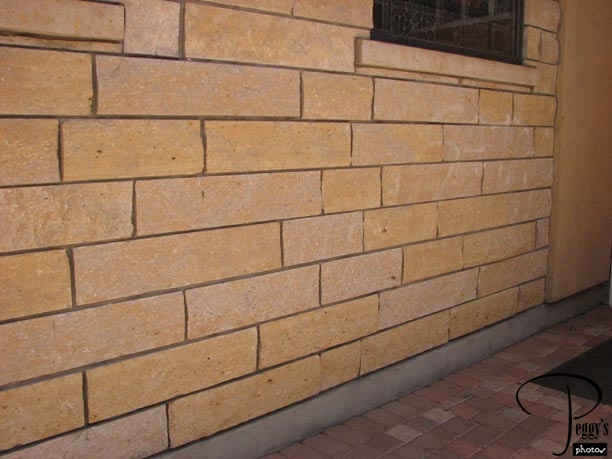
The Cathedral was built of this yellow rock rather than adobe. In Willa Cather’s book, Father Latour (Lamy) needed to take a detour back to Santa Fe and came upon a hill of this yellow rock about 15 miles from Santa Fe. Another story is that, on one of his journeys near Santa Fe, Lamy came upon a house made of this yellow rock. He told others of his discovery and led them back to where the house was, but the house was no longer there but the yellow rock was. Anyway, Lamy was thrilled to have found this rock as it reminded him of material used to build churches back in France.

Santa Fe
Santa Fe
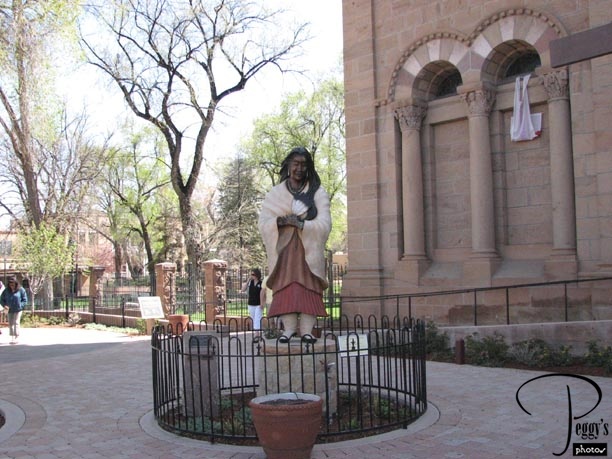
Statue of Kateri Tekakwitha, “Lily of the Mohawks,” in front of the Cathedral. She was a devout Indian Christian who “demonstrated courage in the face of suffering and extraordinay holiness.” She lived in the 17th century and is the only Native American to have been recommended for canonization as a saint in the Roman Catholic Church.

Santa Fe
Santa Fe
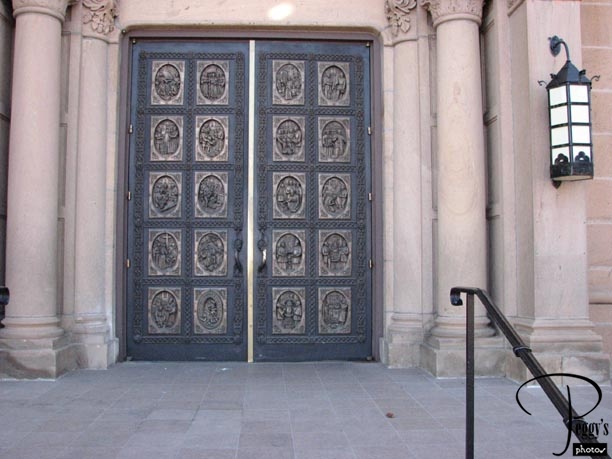
The doors of the Cathedral with carved panels of historic events.

Santa Fe
Santa Fe
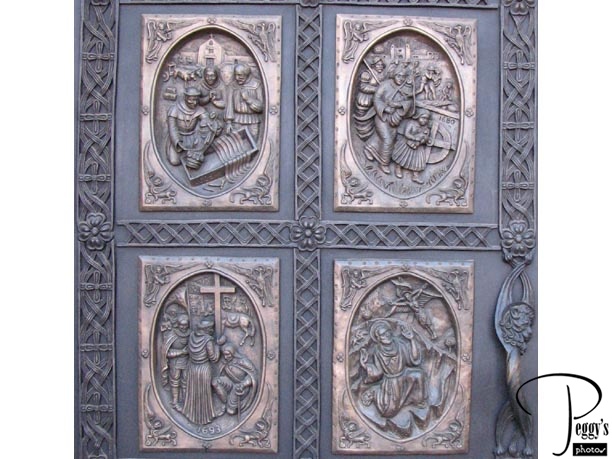
Close–up of the doors.

Santa Fe
Santa Fe
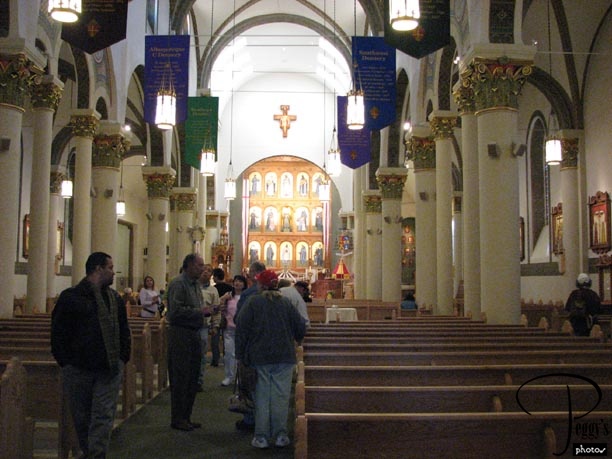
Inside the Cathedral.

Santa Fe
Santa Fe
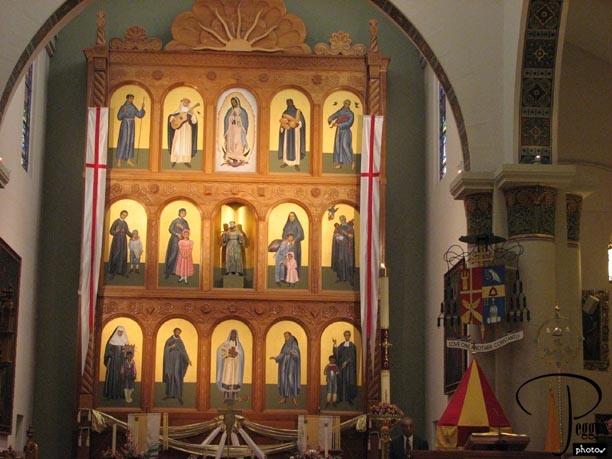
Close–up of the altar screen.

Santa Fe
Santa Fe
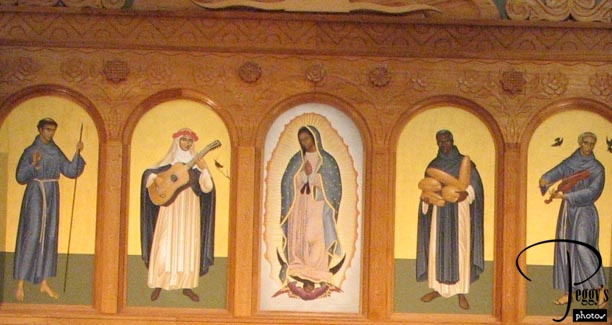
Close–up of the first row of figures on the altar screen. There was a chart in the Cathedral with the names of all the figures. From the left: St. Philip of Jesus; St. Rose of Lima; Our Lady of Guadalupe; St. Martin de Porres; St. Francis Solano.

Santa Fe
Santa Fe
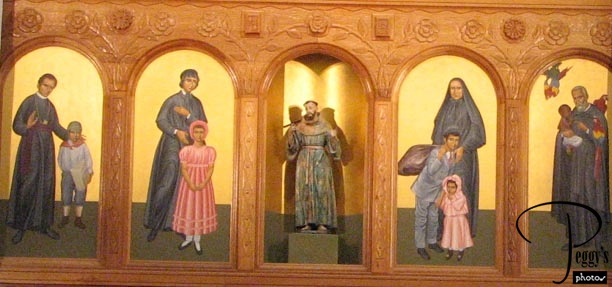
From the left: St. John Neumann; St. Elizabeth Seton; St. Francis of Assisi; St. Frances Cabrini; St. Peter Claver.

Santa Fe
Santa Fe
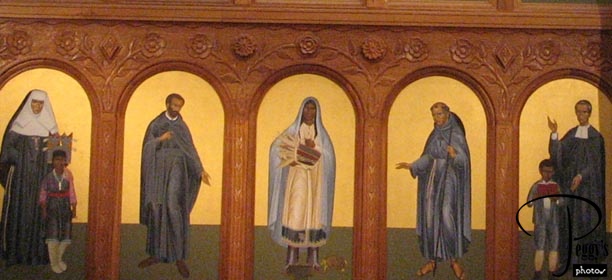
From the left: Blsd. Katherin Drexel; St. Isaac Joques; Blsd. Kateri Tekakwitha; Blsd. Junipero Serra; St. Miguel Febres Cordero.

Santa Fe
Santa Fe
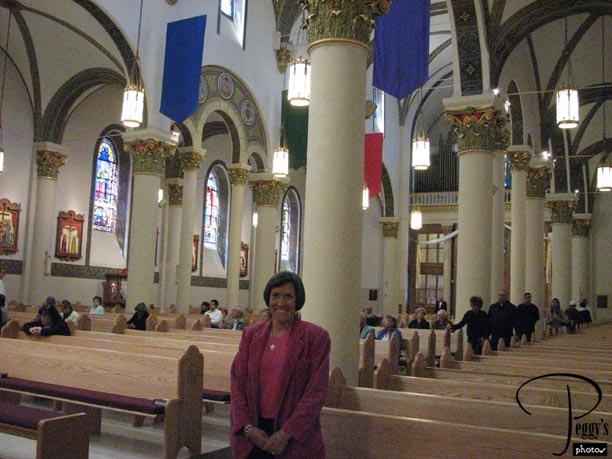
Great photo of Jill taken inside the Cathedral.

Santa Fe
Santa Fe

Another view of the inside of the Cathedral.

Santa Fe
Santa Fe
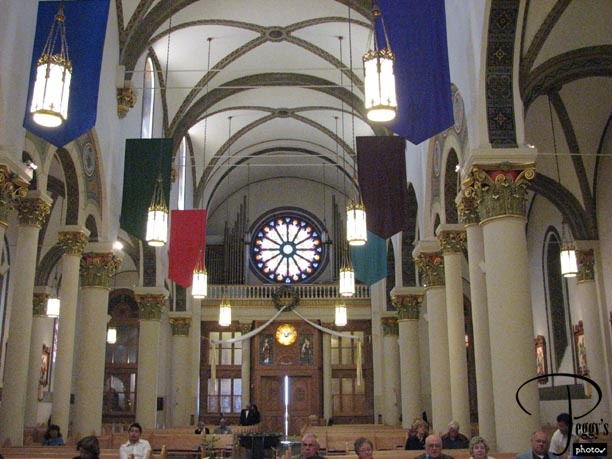
View of the rose window from inside the Cathedral.

Santa Fe
Santa Fe
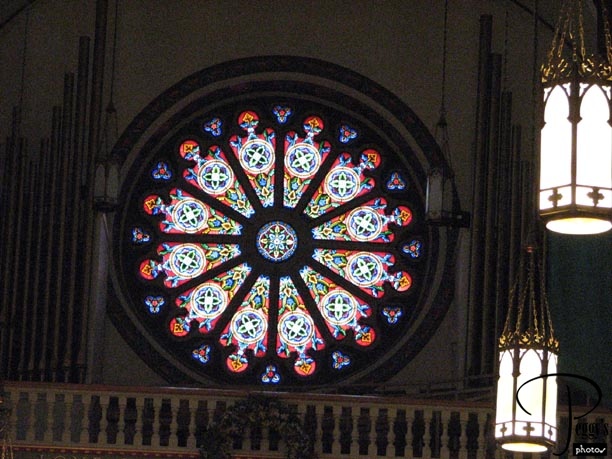
Close–up of the rose window.

Santa Fe
Santa Fe
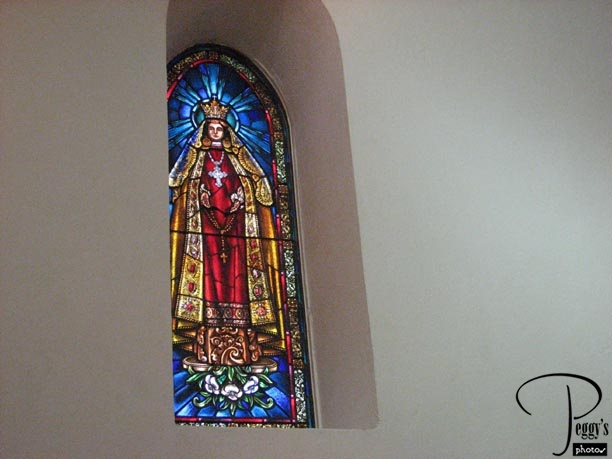
One of the stained–glass windows.

Santa Fe
Santa Fe
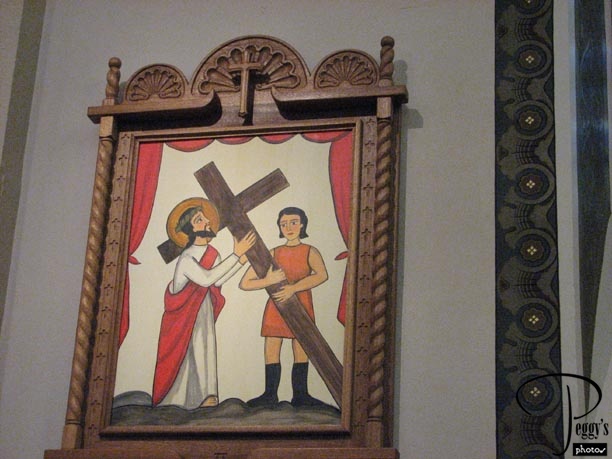
Station of the Cross.

Santa Fe
Santa Fe
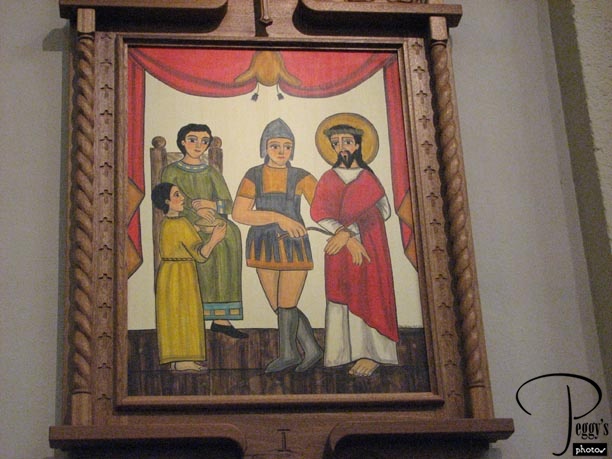
Another Station of the Cross.

Santa Fe
Santa Fe
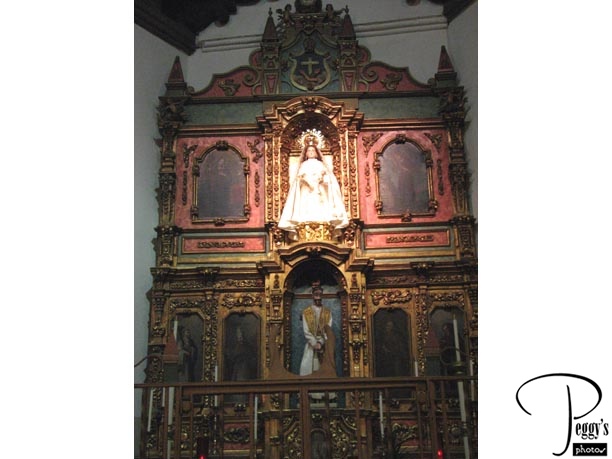
The wooden Our Lady of Peace in the Our Lady of the Rosary Chapel on the side of the Cathedral. The Chapel is the only portion that remains of the original 1610 church, Our Lady of the Assumption, of which the new Cathedral was built over and around.

Santa Fe
Santa Fe
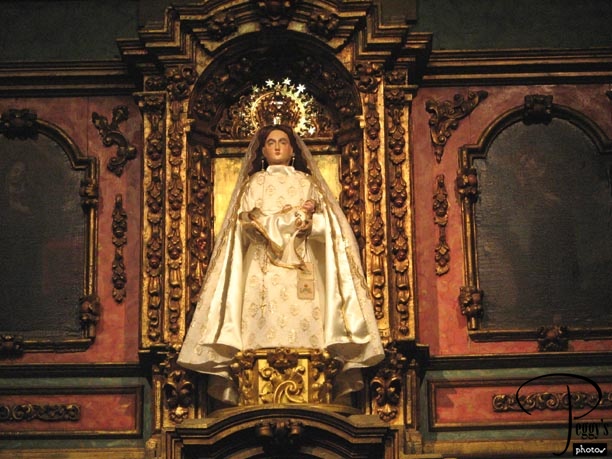
Close up of Our Lady of Peace, which is the oldest representation of the Madonna in the United States. She was rescued from the original church during the 1680 Pueblo Revolt and then brought back to Santa Fe 12 years later by Don Diego de Vargas during the Spanish reconquest.

Santa Fe
Santa Fe
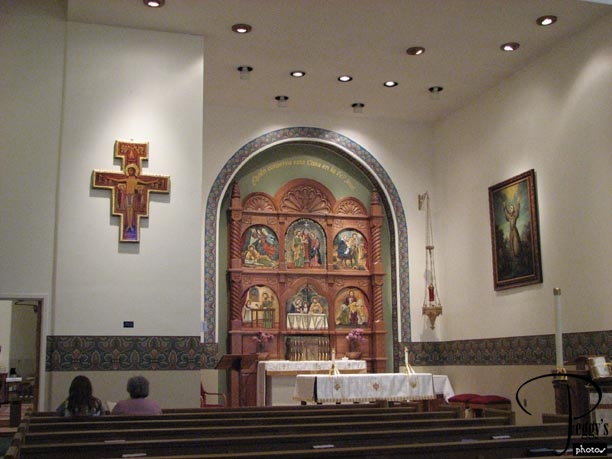
Another chapel in the Cathedral.

Santa Fe
Santa Fe
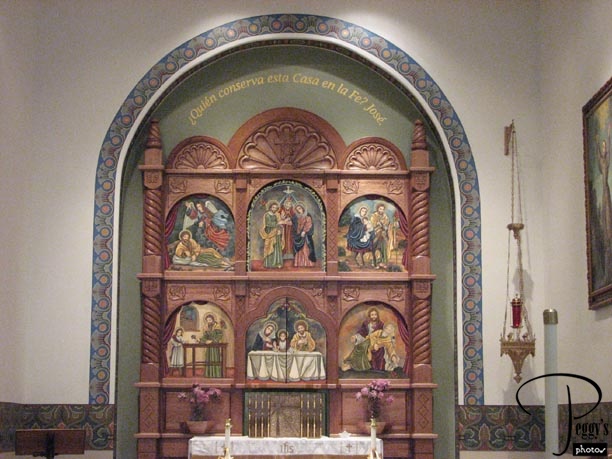
Close–up of the altar screen.

Santa Fe
Santa Fe
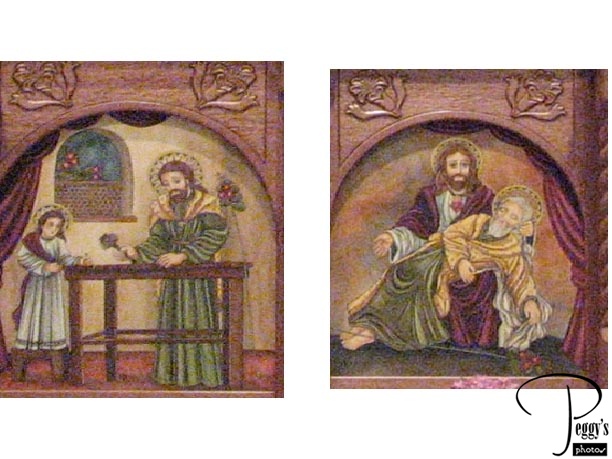
Close–up of two of the altar screen panels.

Santa Fe
Santa Fe
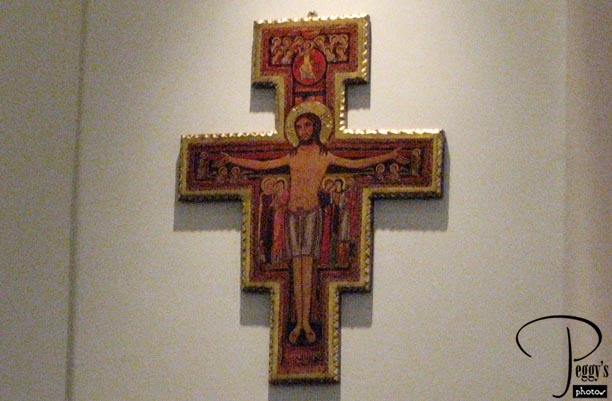
Cross on the wall of the chapel.

Santa Fe
Santa Fe
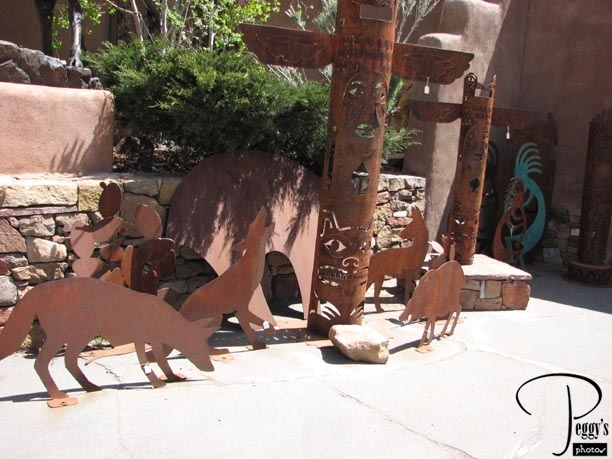
From the Cathedral, we walked to the San Miguel Mission. Metal sculptures for sale seen on our walk.

Santa Fe
Santa Fe
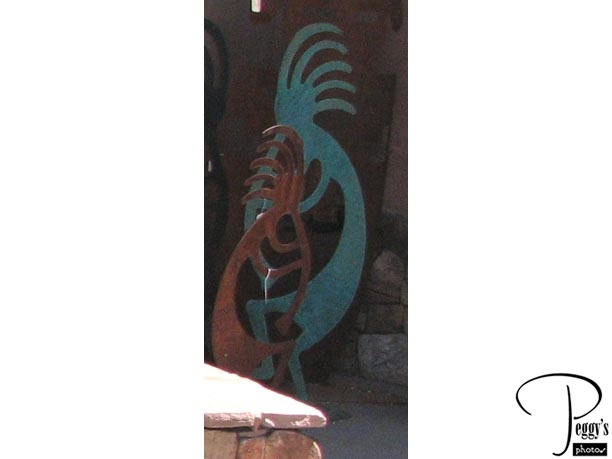
Close–up of two of the metal sculptures. Everyone who lives in New Mexico seem to know who these sculptures are of: Kokopelli. He is “also known as Neopkwai’i. May have used the name of Esteban and Casanova. Occasionally called Water Sprinkler. Has decided hunchback, dark complexion. Carries pack of goods, plays flute, poses as traveling salesman. Was associated with an early Zuni gambler. Sometimes travels with horny woman, who calls herself Kokopelli–mama. He may have been involved in the bankruptcy of Pueblo Bonito in the late 13th century. Hohokam Tribal Police have had an all points bulletin on him for several centuries. Since Basketmaker days he has been wanted on charges of despoiling maiden, seducing wives, and gambling.” Description of Kokopelli taken from a scroll sold at the Bien Mur Indian Market Center.

Santa Fe
Santa Fe
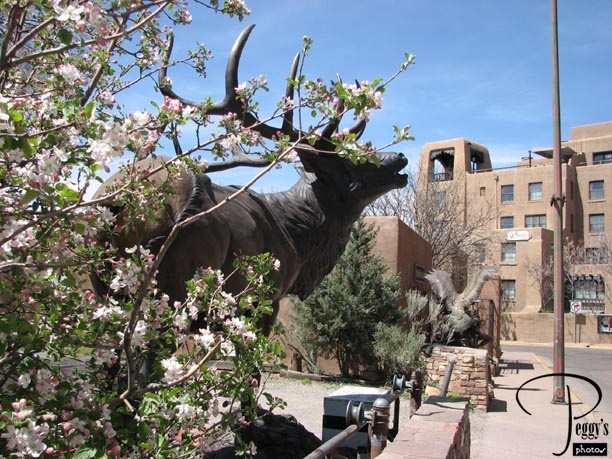
Statue of an elk seen on our walk.

Santa Fe
Santa Fe
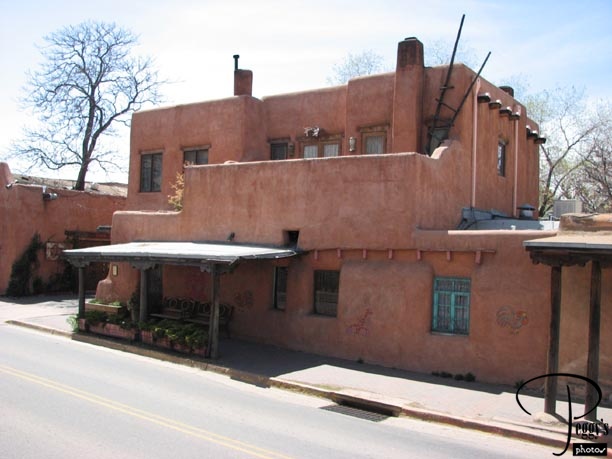
We passed this pueblo building.

Santa Fe
Santa Fe
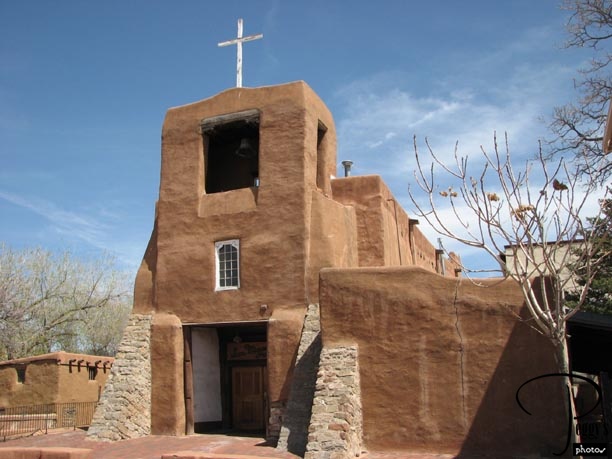
We have arrived at the San Miguel Mission Church. This is the oldest church structure in the United States, with its original adobe walls built in 1610 by Tlaxcalan Indians from Mexico under the direction of Franciscan missionaries.

Santa Fe
Santa Fe
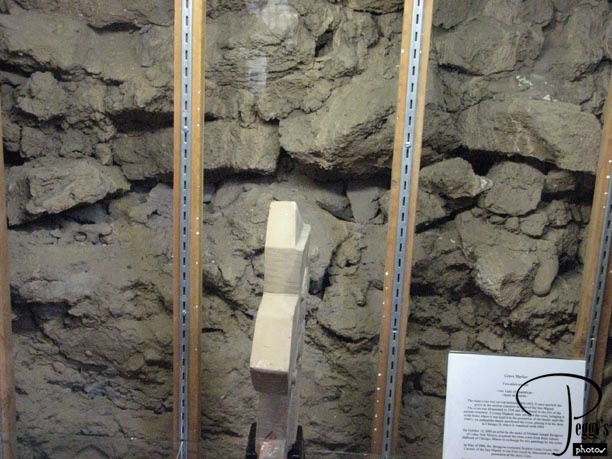
The original adobe walls, shown through a cutout in the now plastered walls.

Santa Fe
Santa Fe
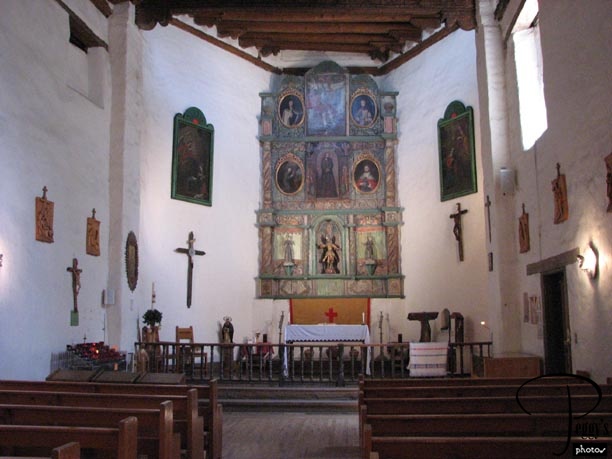
Inside the San Miguel Mission Church.

Santa Fe
Santa Fe
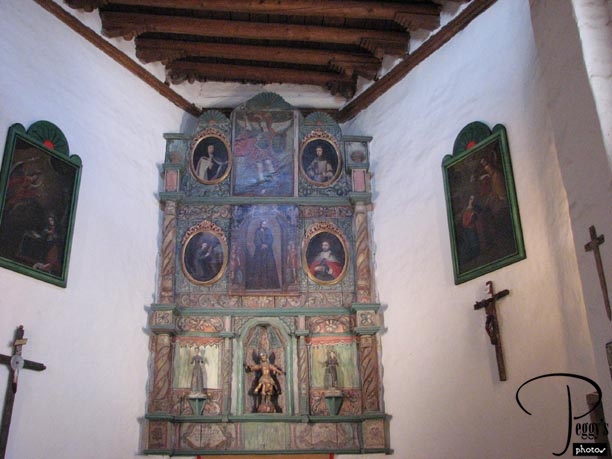
The altar screen dates back to 1798.

Santa Fe
Santa Fe
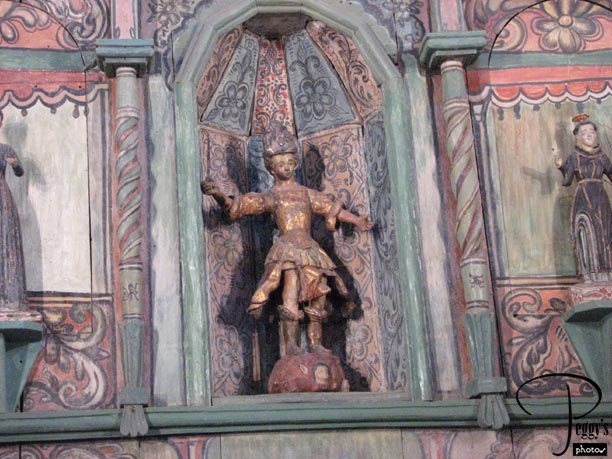
Close–up of one of the figures in the altar screen.

Santa Fe
Santa Fe
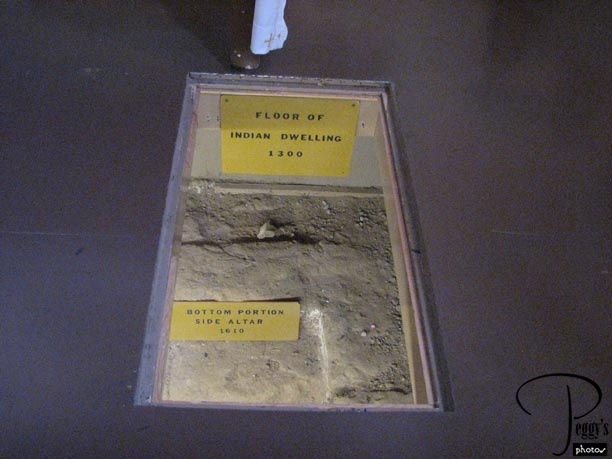
There are several of these cutouts on the floor in front of the altar. Anthropologists have excavated down to the original floor which may be part of a 12th–century pueblo.

Santa Fe
Santa Fe
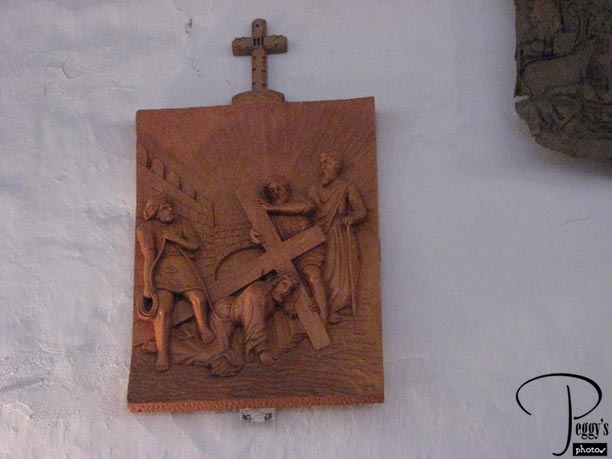
Station of the Cross.

Santa Fe
Santa Fe
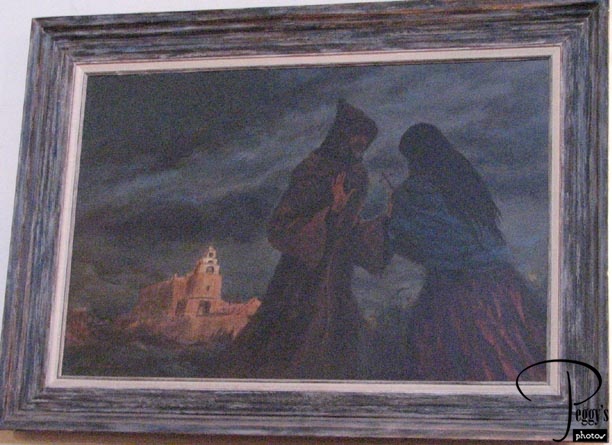
Painting hanging on the wall, probably priceless.

Santa Fe
Santa Fe
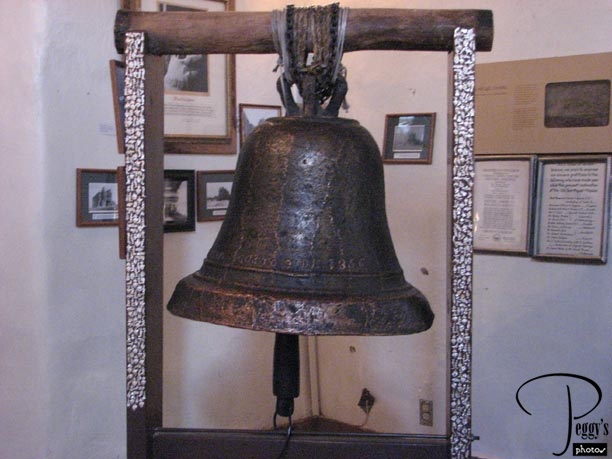
This 780–pound San Jose bell cast in Spain in 1356 is on display in the church. It was used in both Spain and Mexico before being brought by oxcart to Santa Fe in the early 19th century

Santa Fe
Santa Fe
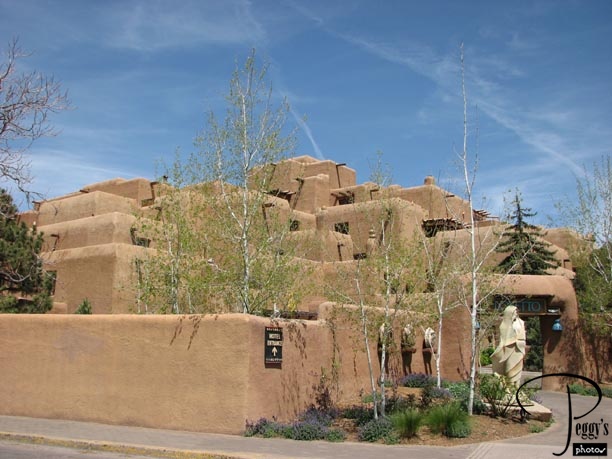
After visiting the San Miguel Mission Church, we head back to the street facing the Cathedral. We passed The Inn and Spa at Loretto which was built in 1975 to resemble the Taos Pueblo.

Santa Fe
Santa Fe
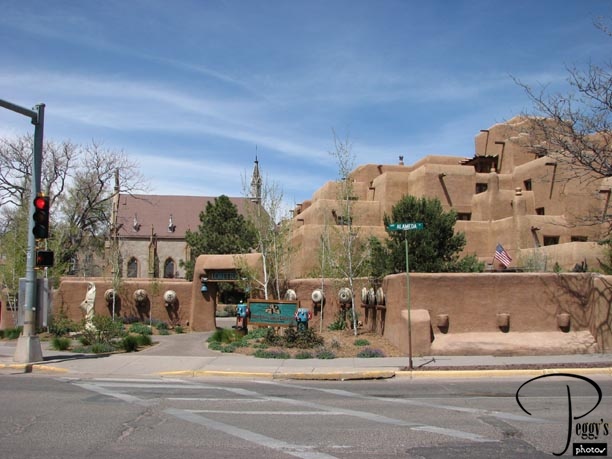
View of both the Inn and Spa at Loretto and the Loretto Chapel. We said good–bye to Jill and Jack at the Loretto Line Tram as Linda and I were going to take a tram tour of Santa Fe. But we all made a date to see each other again in October when I come back to New Mexico to see the Balloon Fiesta in Albuquerque. Linda and I are still talking about how great of a time with had with Jill and Jack and how special they made our trip to Santa Fe. The photos I took on our tram tour of Santa Fe appear on the next album.
